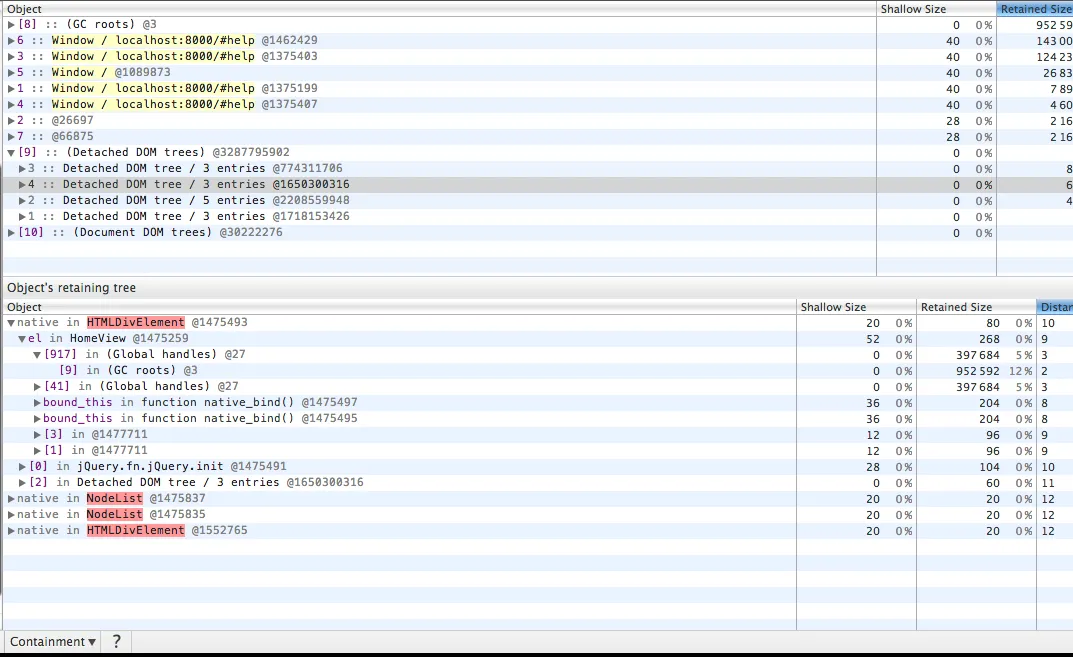我正在尝试找出如何获取引用分离DOM树中的哪个变量。我已经将问题隔离到两个简单的视图,并且正在使用Chrome Dev Tools(在比较视图中)查找是什么引用了分离的节点。我已经附上了Dev工具的图像...

Dev工具的底部显示,HomeView的el创建了一个已经被分离的div。但我不确定下一步该怎么做。
我已经阅读了许多关于定位内存泄漏的Stack Overflow帖子和博客文章,但仍然无法解决这个问题。我知道Backbone特别容易导致内存泄漏,因此我已经实现了“僵尸杀手”技术,但内存泄漏仍然存在。以下是我的视图:
帮助视图
// Generated by CoffeeScript 1.6.3
(function() {
var __hasProp = {}.hasOwnProperty,
__extends = function(child, parent) { for (var key in parent) { if (__hasProp.call(parent, key)) child[key] = parent[key]; } function ctor() { this.constructor = child; } ctor.prototype = parent.prototype; child.prototype = new ctor(); child.__super__ = parent.prototype; return child; };
define(['jquery', 'jquerymobile', 'underscore', 'backbone'], function($, Mobile, _, Backbone) {
var HelpView, _ref;
return HelpView = (function(_super) {
__extends(HelpView, _super);
function HelpView() {
_ref = HelpView.__super__.constructor.apply(this, arguments);
return _ref;
}
HelpView.prototype.initialize = function() {
return _.bindAll(this, "render", "jqdisplay", "close");
};
HelpView.prototype.render = function() {
$(this.el).html("Help View");
return this;
};
HelpView.prototype.jqdisplay = function() {};
HelpView.prototype.close = function() {
console.log('THIS', this);
console.log($(this.el)[0].parentNode);
$(this.el)[0].parentNode.removeChild($(this.el)[0]);
this.undelegateEvents();
$(this.el).removeData().unbind();
this.remove();
this.unbind();
Backbone.View.prototype.remove.call(this);
return delete this;
};
return HelpView;
})(Backbone.View);
});
}).call(this);
主页视图
// Generated by CoffeeScript 1.6.3
(function() {
var __hasProp = {}.hasOwnProperty,
__extends = function(child, parent) { for (var key in parent) { if (__hasProp.call(parent, key)) child[key] = parent[key]; } function ctor() { this.constructor = child; } ctor.prototype = parent.prototype; child.prototype = new ctor(); child.__super__ = parent.prototype; return child; };
define(['jquery', 'jquerymobile', 'underscore', 'backbone'], function($, Mobile, _, Backbone) {
var HomeView, _ref;
return HomeView = (function(_super) {
__extends(HomeView, _super);
function HomeView() {
_ref = HomeView.__super__.constructor.apply(this, arguments);
return _ref;
}
HomeView.prototype.initialize = function() {
return _.bindAll(this, "render", "jqdisplay", "close");
};
HomeView.prototype.render = function() {
$(this.el).html("Home View");
return this;
};
HomeView.prototype.jqdisplay = function() {};
HomeView.prototype.close = function() {
console.log('THIS', this);
console.log($(this.el)[0].parentNode);
$(this.el)[0].parentNode.removeChild($(this.el)[0]);
this.undelegateEvents();
$(this.el).removeData().unbind();
this.remove();
this.unbind();
Backbone.View.prototype.remove.call(this);
return delete this;
};
return HomeView;
})(Backbone.View);
});
}).call(this);
...然后我在我的路由器的一个方法中调用每个视图的 "close" 方法...
MyRouter.prototype.showView = function(view) {
console.log('THIS', this);
console.log("next view", view);
console.log(this.currentView);
if (this.currentView) {
console.log('closing the current view...', this.currentView);
console.log('starting', $('[data-role="content"]').html());
this.currentView.close();
delete this.currentView;
console.log('remaining', $('[data-role="content"]').html());
console.log('should be empty', this.currentView);
}
this.currentView = view;
this.currentView.render();
$('[data-role="content"]').html(this.currentView.el);
if (this.currentView.jqdisplay) {
return this.currentView.jqdisplay();
}
};
漏洞的实时演示在这里:http://bit.ly/15xPrW7。
触发泄漏的行为是使用菜单在两个页面之间导航。
任何帮助将不胜感激!谢谢!
Esc),然后评估$0。 - Paul Irish